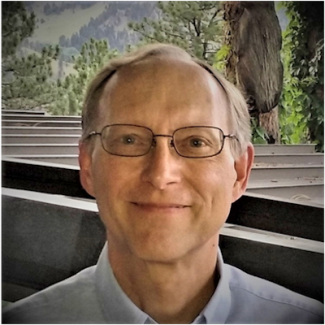Keith Searight joined the DTC in June as NOAA GSL’s co-lead for the Model Evaluation Tools (METplus) verification system, which is becoming the unified verification, validation, and diagnostics software for the Unified Forecast System (UFS). He also performs DTC-wide project management duties for GSL, such as project tracking, budgets, and reporting. Previous to this job, he was NOAA’s technical lead for Science On a Sphere, and continues to do so part time.
Keith grew up in a small college town in central Illinois surrounded by corn fields. After attending college at the University of Tulsa, double majoring in geosciences and computer science, he attended Stanford for an MS in geophysics. Although he started his career as an applied geoscientist in the energy business, he decided to switch to a more computer-focused career, studying computer science part time at CU Boulder. After earning his MS degree, his first software job was a research programmer in the Dept. of Atmospheric Sciences at University of Illinois writing gridded data management and visualization software. Later, he became a commercial software developer, working for several small startup companies. He pivoted his career again toward scientific research labs by joining NCAR’s Research Applications Laboratory in 2008, where he led the software engineering of weather forecasting systems for military sponsors. After NCAR, he worked for a period at the National Renewable Energy Laboratory (NREL) in Golden, then he joined Colorado State University’s Cooperative Institute for Research in the Atmosphere (CSU/CIRA) at NOAA GSL in Boulder seven years ago.
The variety of his work is what inspires him, as his role encompasses software coding, technical writing, and managing people and projects all in the name of improving forecasting skill. On any given day, he might work on budget analysis and tracking, project management and reporting, software testing, application and script coding, and documentation writing.
The study of the earth’s atmosphere and simulating its properties requires programming computer software run on supercomputers. In simplified terms, the focus of his work is developing the software that gauges how close the forecasts matched what actually happened and then generates graphics that help analyze their accuracy. Those results are used to develop and test out new ideas to make our weather forecasts even better.
His first job, however, was a far cry from his current profession. Growing up in the Midwest, summer jobs in the agricultural arena were the most plentiful options for teens. So one summer, he worked in the fields detasseling corn.
Thankfully, he had greater dreams to fulfill. When he was a kid, he aspired to be an astronomer and study the solar system. He had his own telescope and avidly followed the new discoveries and wondrous imagery captured by the spacecraft flying near the planets and moons. Although his eventual career ended up being a little more “grounded,” it just means his focus has been more specifically dedicated to studying just one important planet, our own.
When asked what he loves about his job here, he replied, “I really enjoy the variety of science, technology, and management activities in which I’m involved. I’m inspired by DTC’s mission to partner with NOAA, NCAR, and other organizations to make weather forecasting as accurate as it can be. I also appreciate all the community connections and collaborations that we have across government and academic institutions in the US and around the world.”
Keith has lived in Colorado for decades now. He’s married with two adult sons in college studying nuclear engineering and cyber security, respectively.
Favorite quote? Well, these are strange times, and the following quote seems to fit.
“The optimist proclaims we live in the best of all possible worlds; and the pessimist fears this is true. ~James Branch Cabell
